Notes on the Portrait
of Nikias of Cos*
Zusammenfassung: In den ausgehenden
40er und 30er Jahren v. Chr. beherrschte der Tyrann Nikias von
Kos seine Heimatinsel. Während seiner Herrschaft, deren Dauer
sich nicht exakt rekonstruieren lässt, prägte er Münzen mit
seinem Porträt. Im vorliegenden Beitrag wird argumentiert, dass
die Bildnisse, die entgegen gängiger Forschungsmeinungen weder
das Diadem der hellenistischen Könige noch einen Lorbeerkranz
tragen, sich aus politischen Gründen an denen Marc Antons
orientierten.
Schlagworte: Nikias von Kos (d-nb.info/gnd/102400474),
Bildnis (d-nb.info/gnd/4006627-7),
Marcus Antonius (d-nb.info/gnd/118503529),
Kos (d-nb.info/gnd/4829027-0),
Münzbildnis (d-nb.info/gnd/4308642-1)
Abstract:
In the late 40s and 30s BC the tyrant Nikias of Cos reigned his
homeland. During his reign, which cannot be dated with absolute
certainty, he minted coins with his portrait. This paper argues
that these portraits, neither adorned with a royal diadem nor
with a laurel wreath contrary to former research, were modelled
after those of Marc Antony.
Nikias of Cos is a
figure from the ancient world about whom we are not very well
informed. Despite the facts that he was tyrant of Cos
approximately around the years 40–30 BC and that in this
capacity he minted bronze coins with his portrait on the
obverse, his vita has to be reconstructed with much effort from
scarce hints in literary sources and a very broad but uniform
epigraphic record[1].
This paper will accordingly not rewrite the history of Nikias,
but focus on an analysis of his coin portrait. After a brief
historical introduction, the coinage of the tyrant and the
questions connected with it will be briefly presented. The main
goal of this article is to analyse the portraits on the obverses
of these coins in depth for the first time and discuss them
against the background of relevant contemporary portraiture.
I. Historical background
Rudolf Herzog has, with
great efforts, pieced together the known facts from
Nikias’ life[2].
One of his main achievements is the identification of Nikias the
tyrant with Nikias the philologist and thereby establishing his
early contacts with the spheres of power in Rome[3].
Suetonius characterizes him as an adherent of Pompeius and
Memmius, implying that he was in Rome with them until he was
reported transmitting a love letter of Memmius to Pompeius’
fifth wife. Through this he, together with Memmius, lost the
imperator’s favour and probably left Rome[4].
This episode of 52 BC shows that by this year, Nikias was not
only in Rome, but had already made contact with the powerful men
and women of the time. It is likely that the acquaintance with
Pompeius goes back to the triumphal journey of the imperator
through Asia and Greece after the third Mithridatic war[5].
After a significant
break due to Nikias staying in the East (where
exactly we do not know and Herzog’s assumption that
he went to Athens with Memmius is pure speculation[6]),
our sources mention him again towards the end of 50 BC, being on
his way to Rome in the company of Cicero, who mentions him in a
letter to Atticus as a fellow traveller[7].
From his return on he seems to have spent some time in the Roman
capital, where he again seems to have lived in exclusive
circles. Cic. ad fam. 7,23,4 mentions him in Rome in April 49 BC
and tells us that he is a friend of Cassius, the later
tyrannicide[8].
In 46 BC Cicero mentions Nikias again, this time as a friend of
Dolabella, the later consul[9].
That he could be a demanding guest and yet able to lead
cultivated conversations can be seen from a letter of 45 BC[10],
in which the orator mentions that he does not feel up to being
his host at that moment. Some months later he stayed with Cicero
again[11],
but soon left, being called urgently to Dolabella[12].
Late in 45 BC we find
Nikias in the entourage of this new patron. Cicero informs us
about the special honours Caesar bestowed on the latter, of
which he knew through Nikias[13].
The Coan seems to have been a very clever and opportunistic
personality with wide spread connections in Roman aristocracy.
This seems to have paid off, as we hear from Cicero that
Dolabella, consul since March 44 BC, had chosen Nikias as a
legate to go ahead of him to Greece and maybe Asia Minor to
prepare the war against the Parthians, who threatened the
eastern borders of the empire. By the middle of 44 BC we hear
that he is already in the east, though we do not know where[14].
Unfortunately, literary
sources are scarce from this point onwards. Strabo tells us that
»in my time«[15]
there was a Nikias on the island of Cos »who also reigned as
tyrant over the Coans«[16].
Since this Nikias is mentioned in a list of famous persons
consisting of a pair of scientists and a pair of literary
figures, he can with some confidence, as Herzog has ingeniously
shown, be identified with the Nikias we have so far heard about[17].
Unfortunately, literary sources mentioning him directly are
missing for these interesting years, but the fate of his island
in the time between Caesar’s assassination and the battle of
Philippi is – although scarcely documented – very telling.
Many cities and islands
of Asia Minor suffered in some way from the civil wars, either
by choosing the wrong sides or by being raided. Among these was
Rhodes, which not only had hosted Dolabella on his way to Asia
Minor, but had refused to lend support to the case of the
tyrannicides shortly after[18].
Thereafter the Rhodians first received a letter of Brutus,
warning them to surrender to him and Cassius voluntarily or
risking destruction of their city and slaughter of the male
population[19].
Apparently overestimating the own military power, the Rhodians
decided not to surrender, but first sent a fleet against
Cassius, which was defeated by the Romans in two battles, the
first of which became famous both through literary and
numismatic sources[20].
After this first defeat, a combined attack of naval and land
forces led to the siege and surrender of Rhodes, which had lost
almost its entire fleet.
Surprisingly enough, the
Coans obviously managed the situation much better than their
neighbours. The only literary sources for the year 42 BC, which
let us get a glimpse at the risky and yet successful political
manoeuvre that Cos managed to execute, are three of Brutus’
letters. The first one, written after the defeat of Rhodes,
calls on them to join the tyrannicides’ cause, again threatening
destruction and slavery[21].
From the second letter it becomes clear that Cos must have
decided to support Brutus and Cassius – at least ostensibly.
Brutus calls, in a slightly sharp tone already, for vessels that
the Coans have promised to build and send him as support in his
fight against the triumvirs. It is obvious that he had expected
the ships much earlier, which leaves one wondering about the
seriousness of the Coan offer. Brutus, however, seems to have
waited a while longer without receiving the promised naval
forces. In his third letter to Cos we learn that he has
dispatched a legation to the island to get the ships. His
legates reported to him that they were still under construction,
which resulted in him writing an angry and yet helpless letter,
accusing the Coans of having wasted too much time for their navy
to be of any use.
It can be deduced that
the Coans had managed on the one hand to come to terms with
Brutus, ostensibly supporting him by building a fleet, and on
the other to delay the construction of the promised vessels
without being severely punished for this clever manoeuvre. In
view of the fact that Nikias had been an acquaintance of Cassius
(and possibly Brutus) and is on the other hand known to have
been somewhere in the Greek east around these times, it seems
reasonable to assume that he had returned to Cos by that time
and was the mastermind behind the successful tactical
manoeuvring[22].
This point is strengthened by the evidence of honours bestowed
on him at an unknown time calling him son of the people,
homeland-loving, hero, benefactor and saviour[23].
The uniformity of the inscriptions and the small format of the
bases suggest that they were part of a publicly organised form
of honours for Nikias, involving the dedication of small-scale
statuettes in (probably) private contexts[24].
It is worth noting, however, that the epigraphic formula does
not imply a cult for Nikias as a god or demigod, but only
attests offerings pro salute /
ὑπέρ[25].
Having guided the island through the dangers of Roman civil war
and the interests of its imperators seems a suitable reason for
being honoured the way Nikias was[26].
Only two further facts
about Nikias are known. First of all, we know that at a certain
point he became tyrant of Cos[27].
Herzog thinks that the coins which will be discussed below and
the above-mentioned inscriptions and honours suggest that his
tyranny was not founded on force, but the circumstances as well
as the exact dating of his rule must remain uncertain[28].
It might be deduced from further examples in the east
Mediterranean that Nikias was among the rulers installed by
Antony after the battle of Philippi[29].
This would, if he had not established himself earlier, make it
probable that he came to power in 41 BC, maybe by being deployed
by Antony or confirmed by him. Whatever might be the case, we
know that Cos was on good terms with Antony, since the island
allowed him to seize timber (including from a holy grove of
Asklepios) for ships before Actium[30].
We also know of Roman citizenship and privileges in commerce
granted to a group of Coans by Antony at an uncertain date
probably in the early 30s BC[31],
making it probable that he maintained connections with the
island and its influential inhabitants.
We do not know much more
about the reign of Nikias. Apparently, he died at some point
late in the 30s BC, receiving an ordinary burial. After Antony’s
defeat at Actium, however, and maybe in connection with the
execution of Turullius for defiling the grove of Asklepios, the
Coans angrily reopened his grave, dragged the corpse out and
»killed him a second time«[32].
As a reaction, Octavian seems to have issued a decree to protect
tombs and the bodies of the diseased[33].
Apparently, the inhabitants of Cos were having their revenge on
Nikias for lining them up with the defeated party of the Roman
civil war[34].
II. Coinage
During Nikias’ reign,
coins with his portrait were issued by a variety of eight
magistrates whose actual function remains unclear[35].
It is usually assumed that they are eponymous magistrates, thus
indicating that the coins were minted over a span of at least
eight years, concluding that the tyrant’s reign lasted at least
from 38 to 31 BC[36].
However, Christian Habicht has shown that there is no reason to
assume that the magistrates signing the coins were the eponymous
ones or even yearly changing[37].
They can therefore not be used to date the reign of Nikias, nor
can they provide a pattern of minting. Vassiliki Stefanaki’s die
study furthermore found several connections of dies between
different magistrates, indicating that minting might to some
extent have happened in parallel[38].
We simply do not know if coins were emitted annually or not. A
date between the late 40s and 31 BC is hence the closest we get
at the moment. This is also in accordance with the numismatic
phenomenon of coinages of quartuncial standard appearing in the
eastern Mediterranean[39].
The coins in question
here are large bronzes engraved by skilled die cutters. The
weights, according to Stefanaki’s die study, range from 16,28 to
25,46 g with an average of 20,85 g (66 pieces). She has drawn
attention to the fact that with this average weight they fit
nicely into a variety of local and colonial coinages as well as
the so-called fleet coinage of Marc Antony, suggesting that the
coins were oriented towards the Roman numismatic and economic
sphere[40].
Diameters range from 30–33 mm and dies are fixed at 12 h. The
obverses show a portrait of Nikias to the right with the legend
ΝΙΚΙΑΣ[41],
the reverses are adorned with the bearded head of Asklepios to
the right, wearing a laurel wreath tied with a tainia. The
accompanying legends name the people (KΩΙΩΝ) and one of the
above-mentioned magistrates.
Since Stefanaki’s
thorough study of the issue, only few new examples have turned
up on the international market[42]
(table 1):
|
No |
Weight |
Dies |
Commentary |
Provenance |
|
1 |
22,75 g |
E9 / O15 |
Stefanaki 2012,
282 no. 2197; 494 fig. 2197 shows the closest parallel
(one correction has to be made in Stefanaki’s catalogue:
her numbers 2192 and 2193 cannot be from the same
obverse die). |
Gorny & Mosch Giessener
Münzhandlung, Auktion 181 (12.10.2009) no. 1782 |
|
2 |
19.24 g |
E14 / O28 |
Stefanaki 2012,
283 no. 2231; 498 fig. 2231 shows the closest parallel. |
Helios
Numismatik, Auktion 3 (29.04.2009) no. 56 |
|
3 |
21,42 g |
E16 / O37 |
Stefanaki 2012,
283 no. 2237; 499 fig. 2237 shows the closest parallel. |
Naville
Numismatics Ltd., Auction 31 (14.05.2017) no. 130; ex
E.E. Clain-Stefanelli collection |
|
4 |
24,95 g |
E4 / O12 |
|
Roma Numismatics
Ltd., E-Sale 31 (26.10.2016) no. 154 |
|
5 |
19,05 g |
E15 / O43 |
|
Roma Numismatics
Ltd., E-Sale 99 (07.07.2022) no. 407 |
The new examples do not
add anything new to the corpus in terms of magistrates or dies.
The main focus of this
paper is the iconography of the coins, more specifically the
iconography of their obverses, the reverse image being quite
straightforward and understandable in the context of Cos.
Concerning the portrait of Nikias on the obverses on the other
hand, some significant misunderstandings have dominated
scholarship up to now.
The first one concerns
the headdress. It is either interpreted as being a diadem[43],
a tainia[44]
or called an unspecific wreath, sometimes with a questionmark[45].
Kostas Buraselis wanted to identify it as some sort of knotted
(woollen) band, marking Nikias as being in some form sacred,
between the spheres of humankind and gods[46].
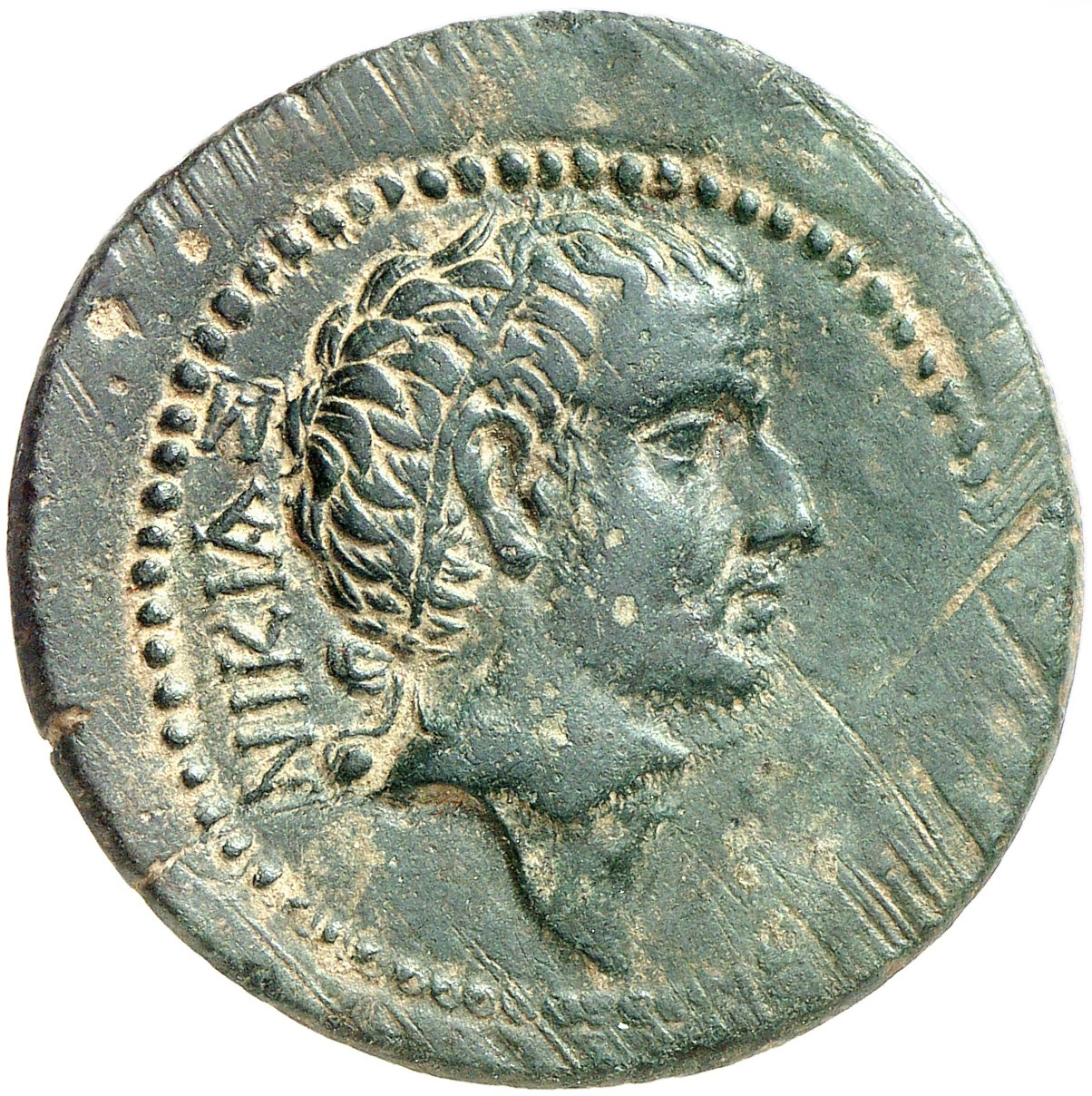
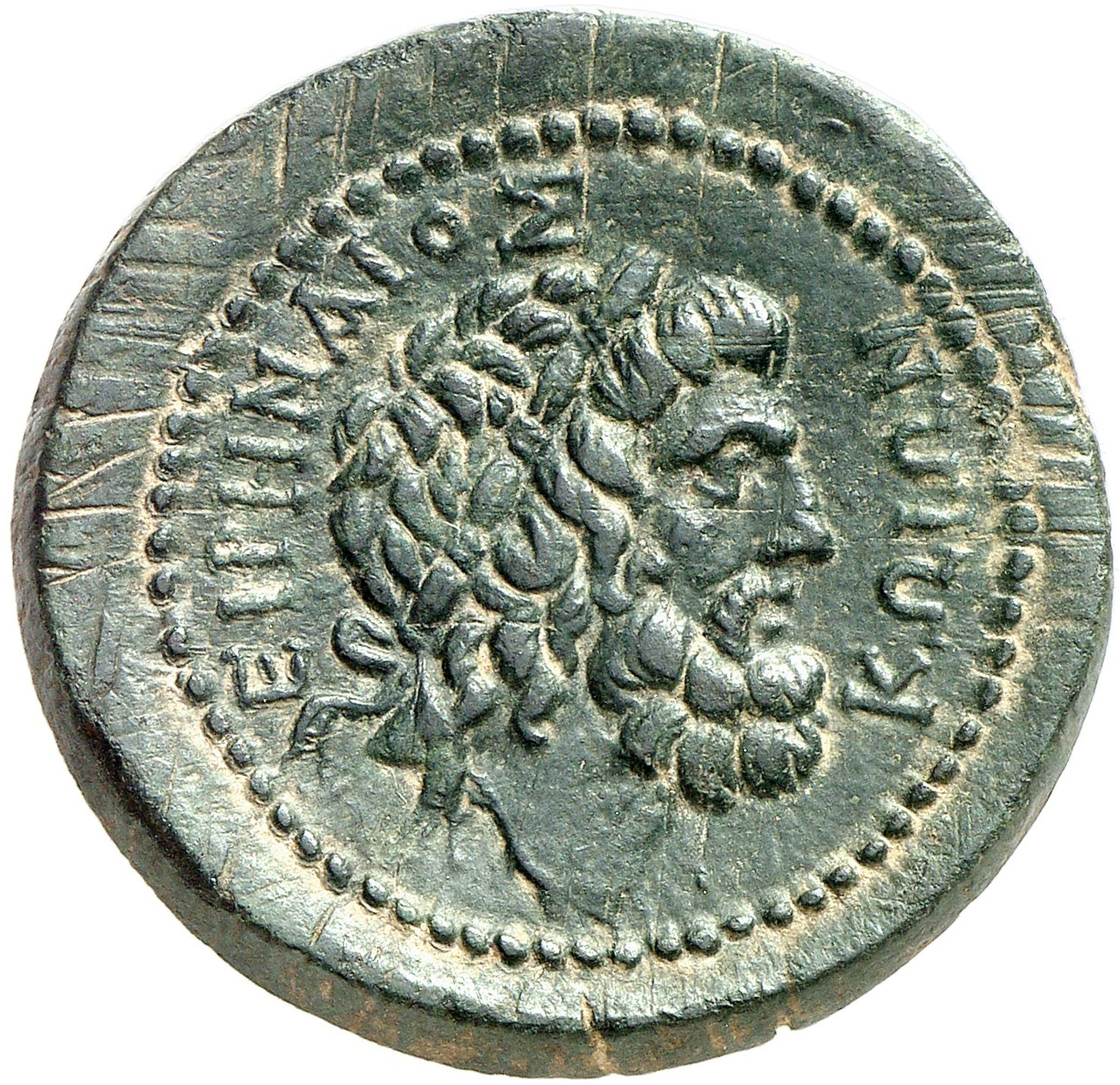
Andrew Burnett was, as
Buraselis also saw, certainly right with his verdict that what
we see on Nikias’ head »certainly does not look like a diadem«[47].
The diadem was a broad band, sometimes with decoration, tied on
the back of the head and ending in a straight form (not with a
pointed knot as a tainia)[48].
The differences to what is shown on these Coan coins are
striking. But it is also obvious that one main argument of
Buraselis is certainly wrong[49]:
The headdresses of Nikias on the obverse and Asklepios on the
reverse are certainly not the same. In addition, his
identification of the latter’s headdress as a twisted, knotted
headband is not correct. Burnett was right in identifying the
wreath of the god as a laurel wreath. It is, admittedly, a
slender one, with what seem to be two rows of laurel leaves very
closely together. And Buraselis might have seen something very
interesting, as a close examination of one of the better
preserved coins of the series shows (fig. 1). It looks as
if in regular intervals something is attached to the laurel
wreath, giving the impression of loops. In addition, it is not
tied with a tainia but with what seems to be a royal diadem.
This feature can be observed several times, but has not yet been
sufficiently explained[50].
However, the general picture of the main god of the island
wearing a laurel wreath remains valid.
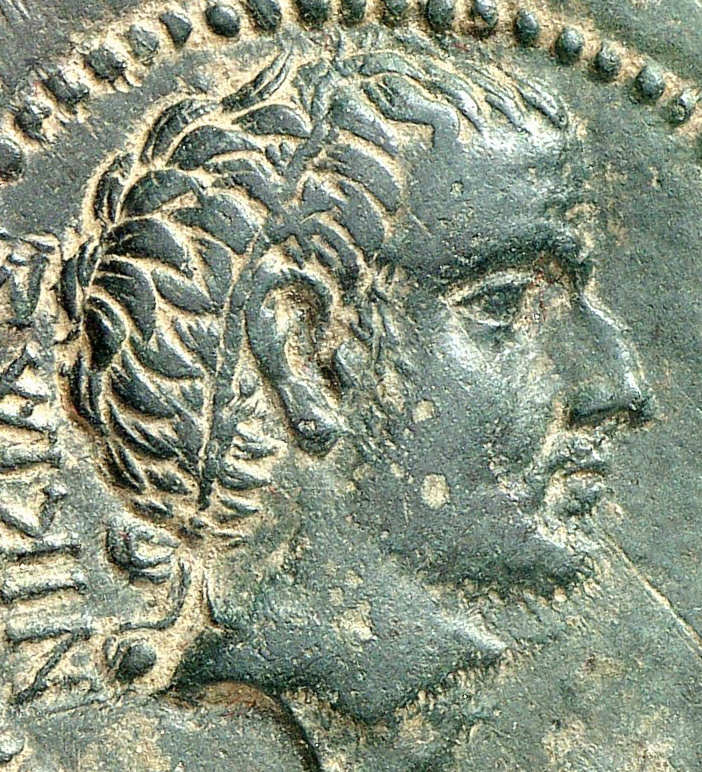
If Nikias is not wearing
a diadem and not a ›Heroenbinde‹, two possibilities remain for
the identification of his headdress: a tainia or a wreath. Both
are correct, as is clearly shown by the enlargement of the
obverse of the coin shown above (fig. 2). Thin stalks and
leaves or needles emanating from a slim branch are easily
discernible. The wreath is, on the other hand, tied at the back
of the head with a tainia, actually making this a combination of
two insignia, a wreath and a tainia[51].
The plan used for the wreath is not easy to make out, given the
wear of the coins and the closeness in style of leaves and locks
of hair. The form of the leaves exclude that it is laurel. One
might think of Mediterranean cypress, as the sacred grove of
Asklepios on Cos consisted of cypress trees and it was centre of
cultic processions on the island[52].
The cypress was one of the sacred plants attached
to Asklepios[53].
The form of the twigs however seems to exclude an identification
as cypress, since they are not ramified enough[54].
The question as to which leaves are meant has to remain open.
The tainia is, both in Greek and Roman culture, sign of victory
and was therefore given to victors (both in real life as well as
in art, in many cases directly by Nike/Victoria)[55].
Building on this tradition we find examples of Hellenistic kings
shown wearing a combination of laurel wreath and tainia in
situations in which they seem to have been in some way
victorious or successful[56].
Nikias could therefore be marked, with the combination of a
wreath and tainia, as both victorious and as a worshipper, maybe
even a cult member, of Asklepios[57].
Nikias’ portrait has
already received some scholarly attention, especially by Burnett[58]
and Buraselis[59].
As the latter observed quite correctly, the wear of most of the
examples of the coins makes it difficult to derive all the
necessary details of the head from only one coin. The plates in
Stefanaki’s publication are certainly helpful to get a general
overview, although one has to admit that the print quality is
not too high[60].
The following description is based on a combination of several
pieces of above average preservation in enlargements (figs.
2–5).
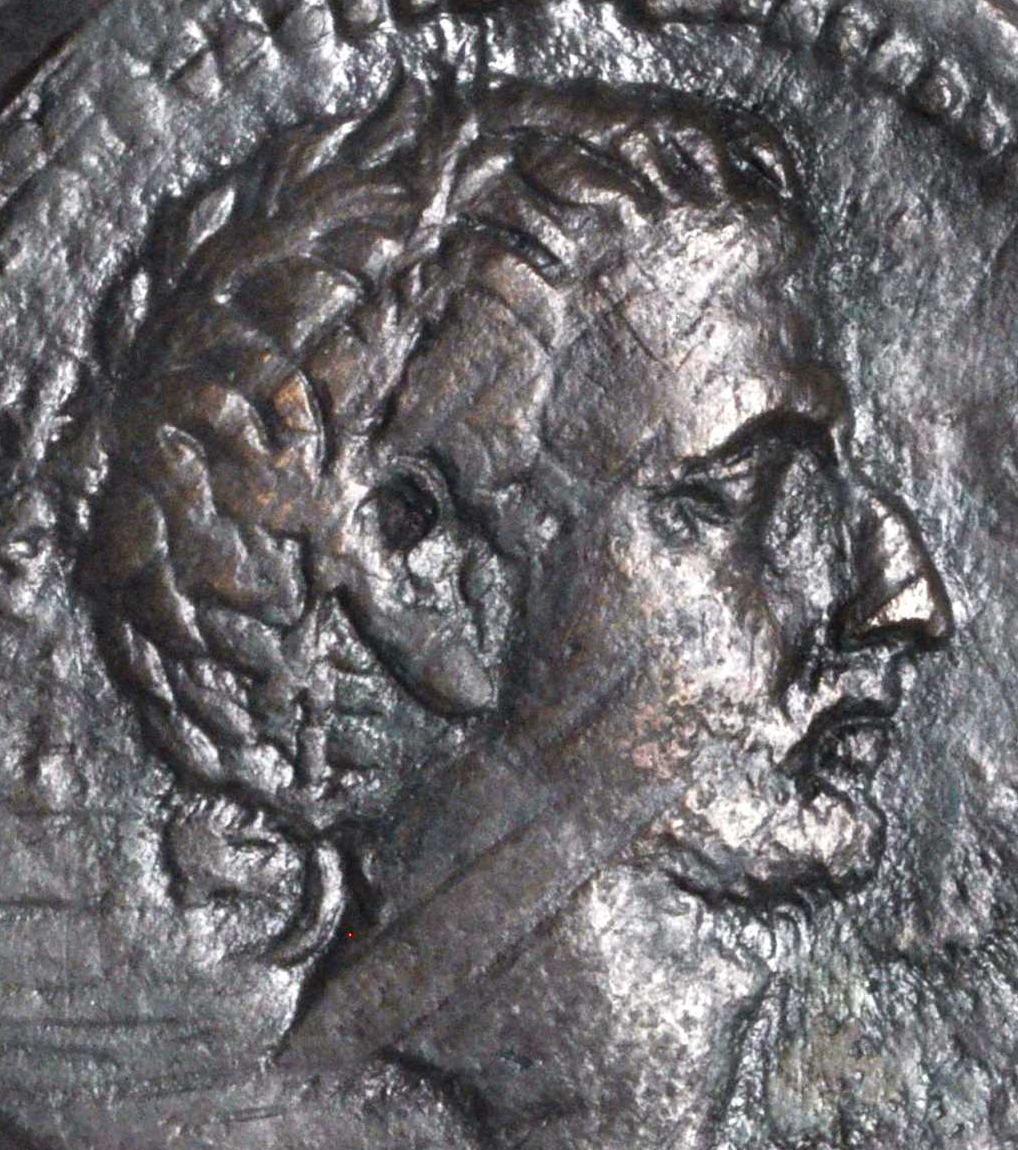
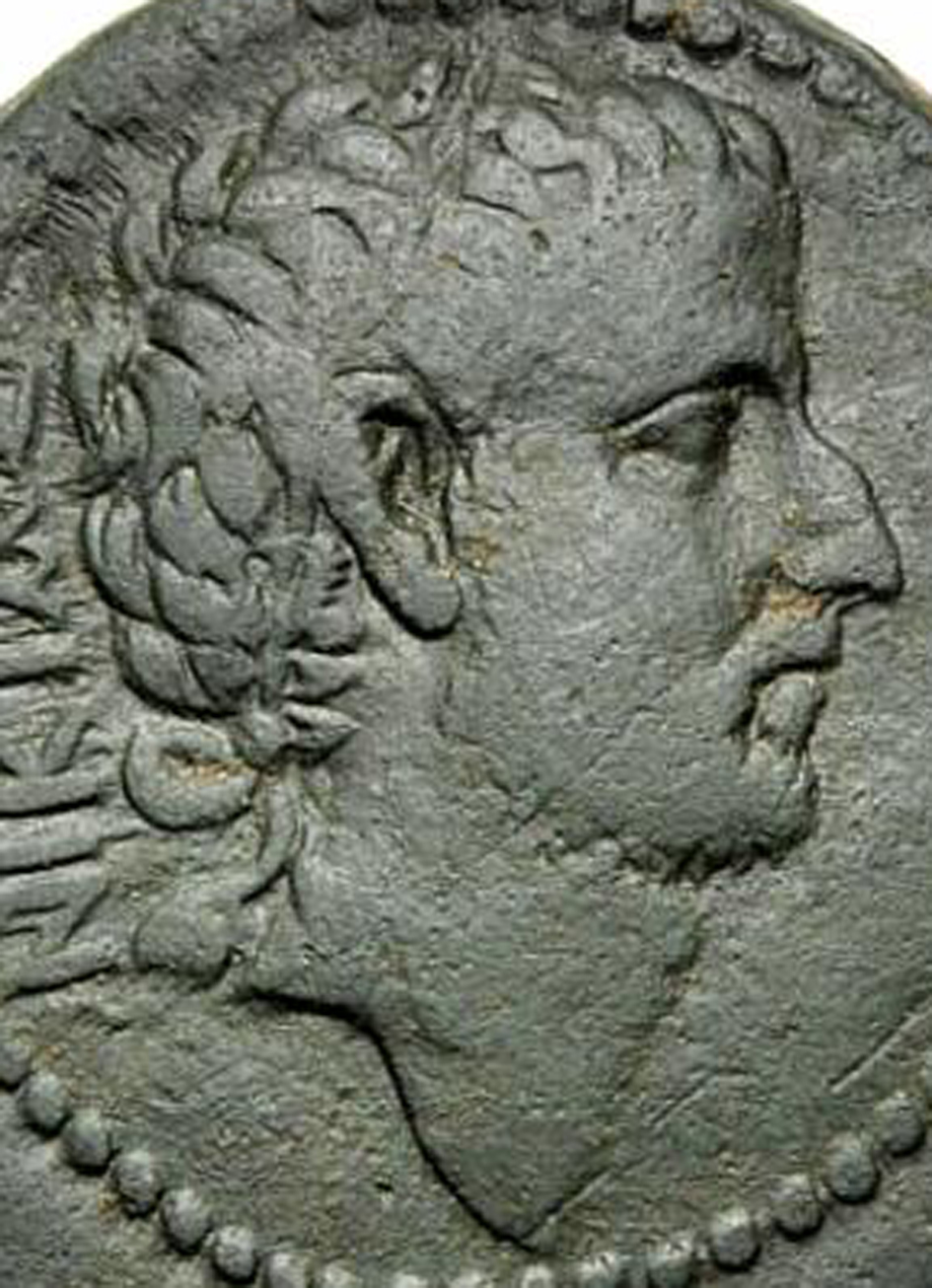
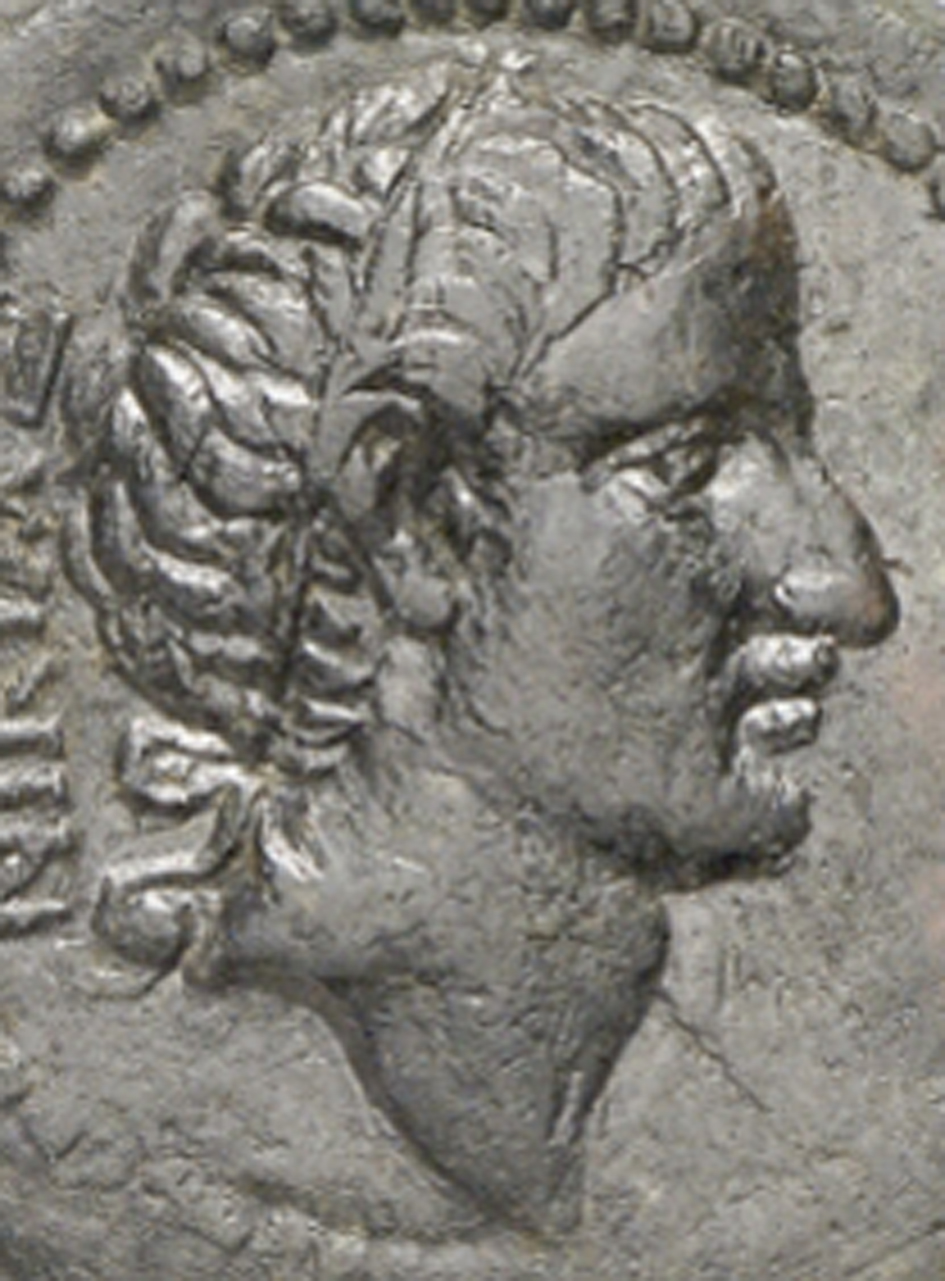
The skull, structurally
defined by its bones, is mounted on a narrow, sinewy neck with a
prominent Adam’s apple. The back of the head is regularly
rounded, whereas the face from the small pointed chin to the
very high forehead is quite flat. A marked break is formed by a
big, hooked nose with a protuberance marking it might have been
broken at one point. From its sides, long and deep nasolabial
folds stretch towards the sides of a narrow mouth formed by
regular lips, itself accompanied by sharp folds. The bulging
brows are knitted above the nose, contracting with them the high
forehead, leaving one or two parallel wrinkles across it. Thin,
finely cut eyelids cover almond-shaped eyes while the lower
eyelid fades into a slender lacrimal. Sharply incised, short
crow’s feet complete the carefully composed eye region. The hair
consisting of slim, curved locks emerges from a swirl on the
back of the head. Over the forehead the sparse locks of hair
form quite a well-defined hairstyle. Three strands are combed
forward into the forehead, as if to hide a gradually growing
baldness. Towards the right temple they are followed by a lock
forming an S and four further locks simply curved downwards over
the elongated ear. Cheeks, chin and upper lip are covered by a
short, regularly trimmed beard. The head is adorned, as stated
above, with a combination of wreath and tainia.
This portrait, with
clear traits of verism, smooth and taut skin as well as
contractions as marks of concentrated effort, fits well into a
line of late Hellenistic royal portraiture as defined by rulers
like Antiochos I, Orophernes, Hiero II or Philetairos[61].
In Nikias’ lifetime, this style of portraits was popular in
Rome, while also clearly having Greek roots, both in civic and
royal portraiture[62].
Recent scholarship has
more or less unanimously concluded that Nikias’ portrait was
influenced by the early portraits of Octavian[63].
This is, on the one hand, politically unlikely, given the fact
that Cos in general and Nikias in particular
maintained connections with Antony[64].
Furthermore, it would have been unwise, even if there had been
no direct connection between the island and the imperator, to
show too much sympathy with the cause of Octavian in the realm
under Antony’s rule.
Apart from these
arguments, Octavian’s portraits are also markedly different in
style and conception from those of Nikias. First of all it is
quite obvious that there is no similarity with or dependence on
the portraits of the so-called Octavians-Typus[65].
Two schemes of portraits remain in discussion[66].
Scheme I was used for
coins between 43 and 38 BC and its portraits are characterized
by a youthful, smooth and unspecific physiognomy. The round
heads show a full, almost chubby integument, a long pointed
nose, a small chin slightly bent upwards and a small,
full-lipped mouth. A closed, even cap of short, straight locks
encloses the head[67].
(figs. 6–8)
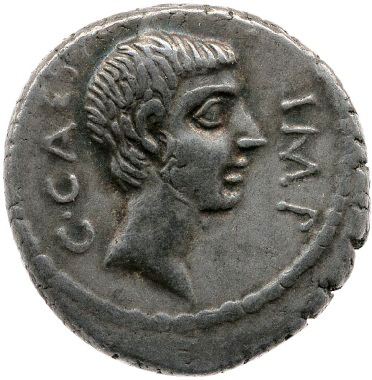
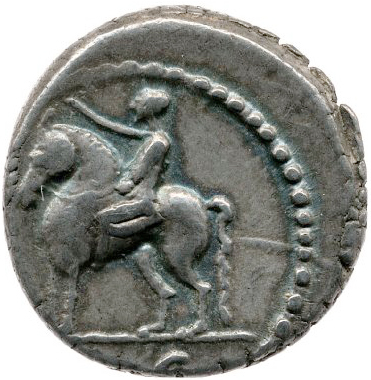
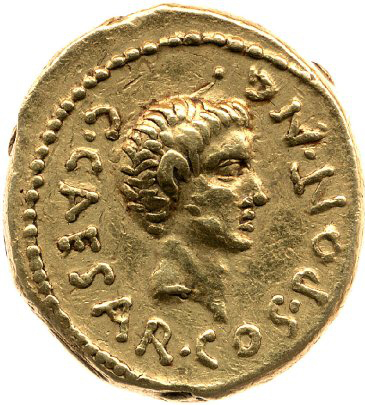
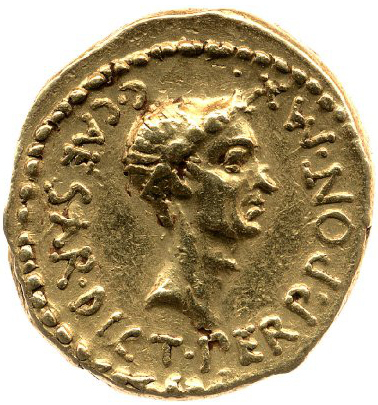
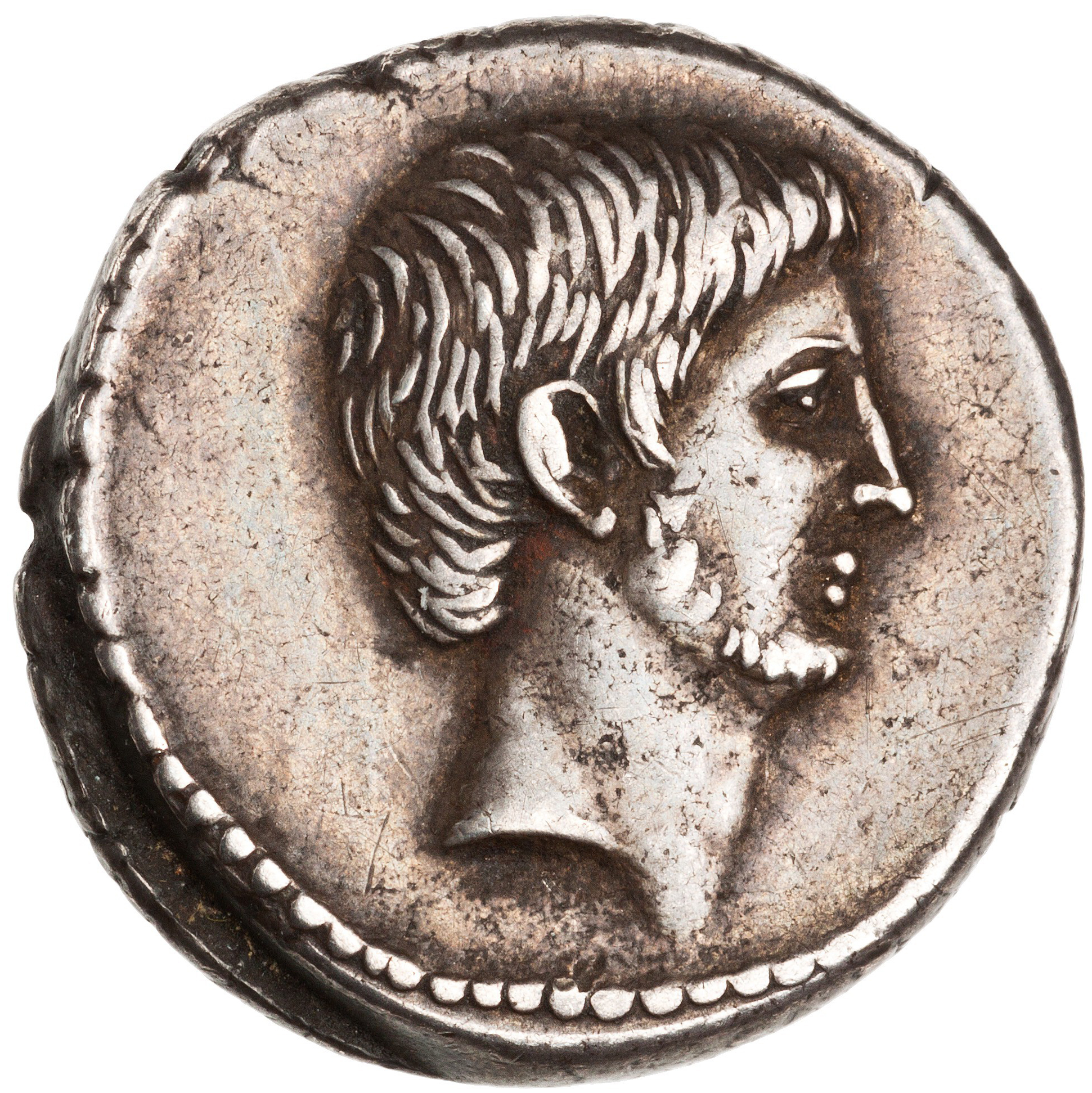
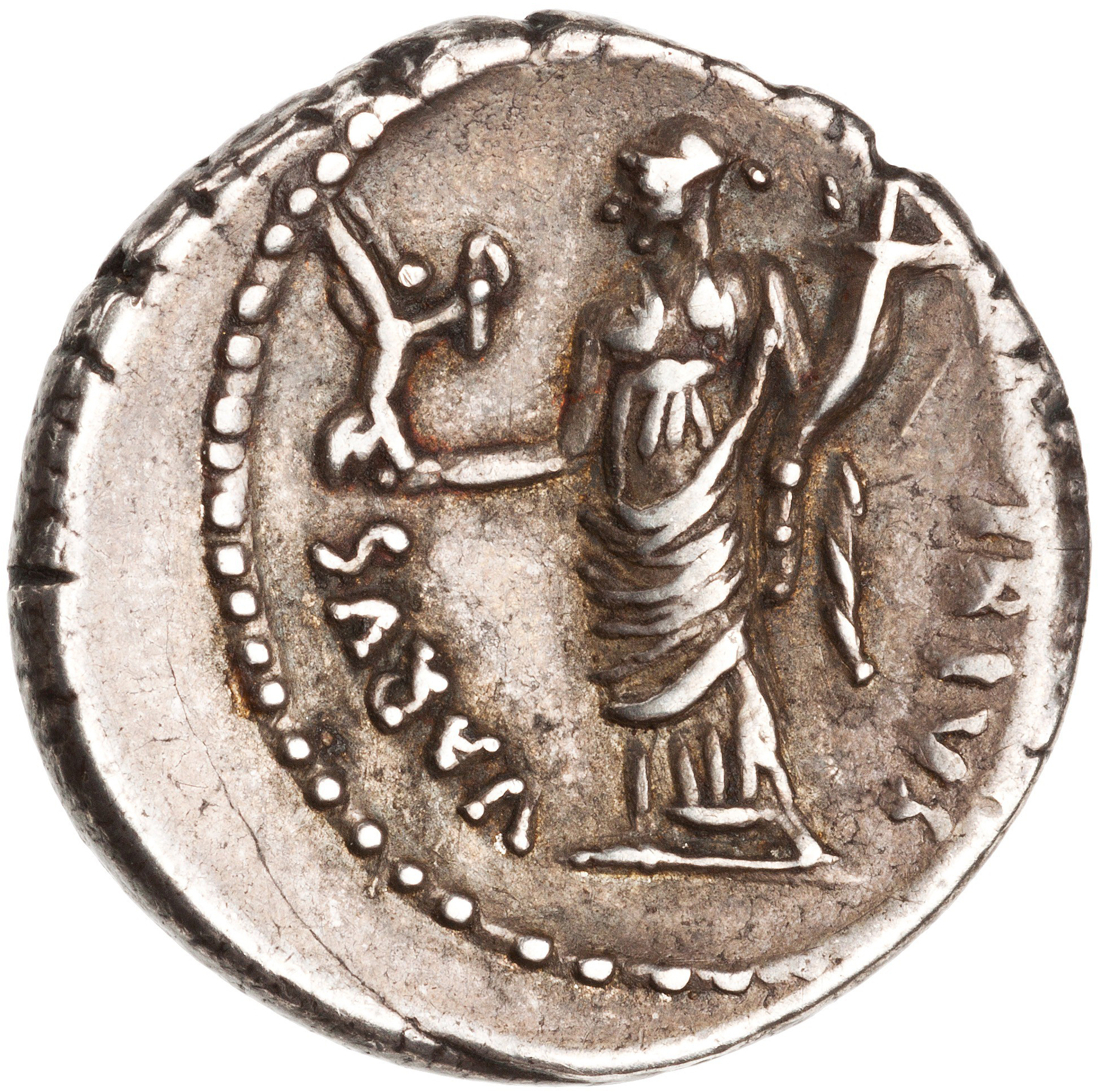
Since 42 BC, scheme II
was in use in parallel with scheme I. Its portraits were minted
until 36 BC – after 40 BC, in parallel with the first portraits
of the ›Octavians-Typus‹ – when the so-called
Siegesserie marked a turning point both in the depiction of
portraits on coins[68]
as well as in the history of the treatment of portraits in
general – from a more general scheme which was not copied in
every detail to a portrait type with copies as exact as possible[69].
The physiognomic characterization of the portraits is the same
as with coins of scheme I. The variation can be found in the
hairstyle, as the portraits of scheme II show a role of hair at
the neck of the head and above the forehead. Both are more
voluminous than the rest of the hair, which is evenly combed
downwards in straight locks again[70].
(figs. 9. 10)
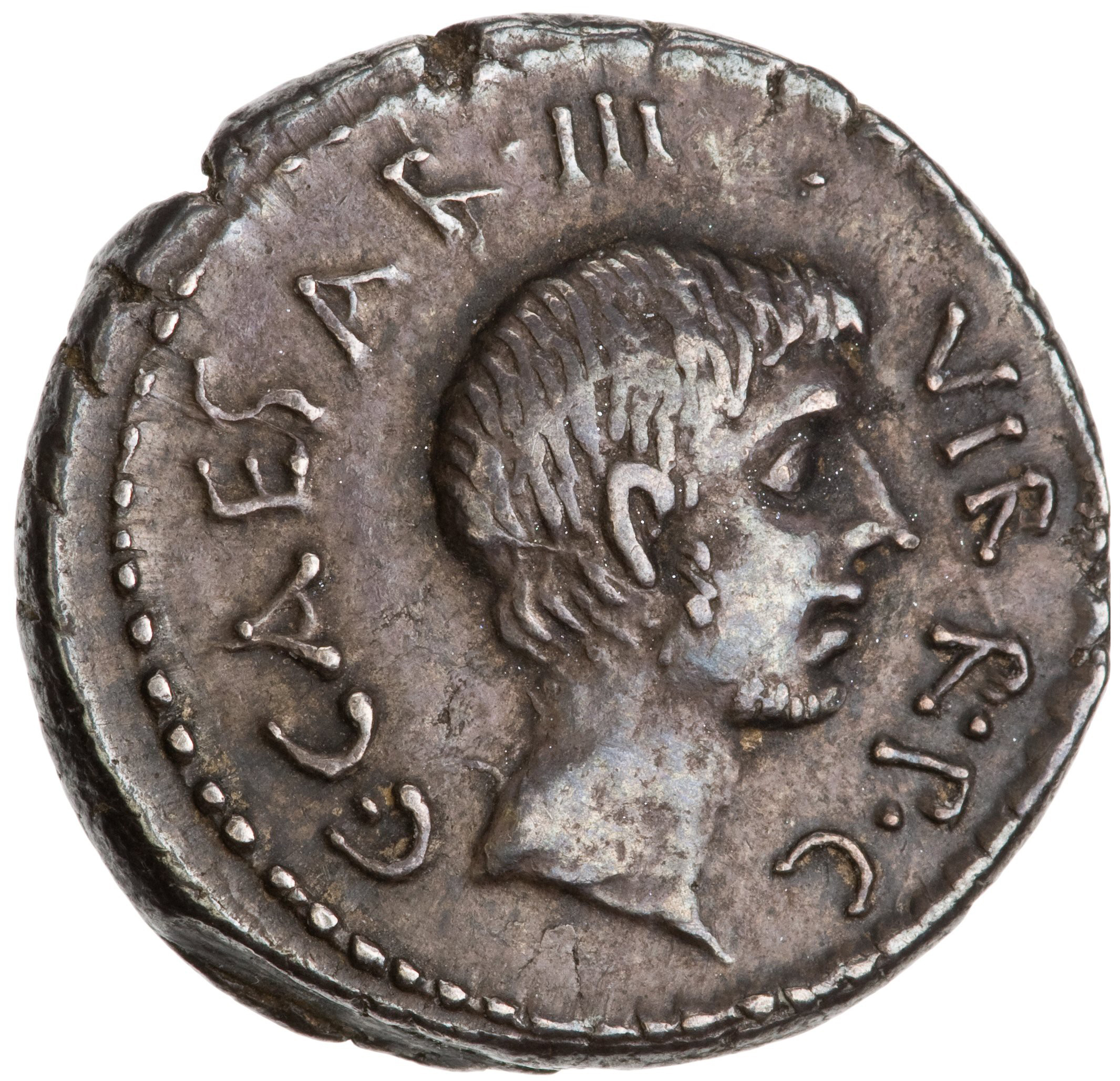
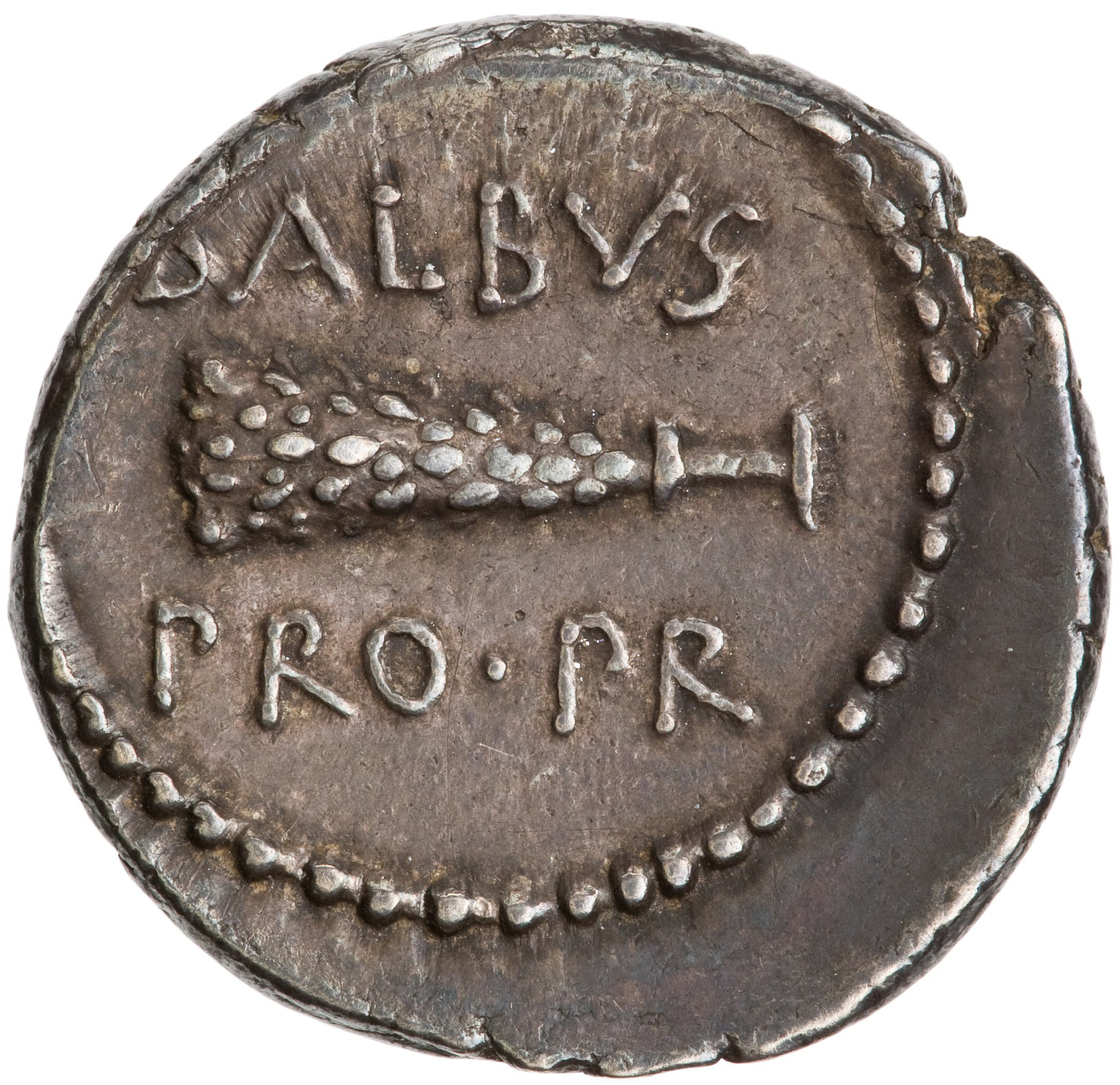
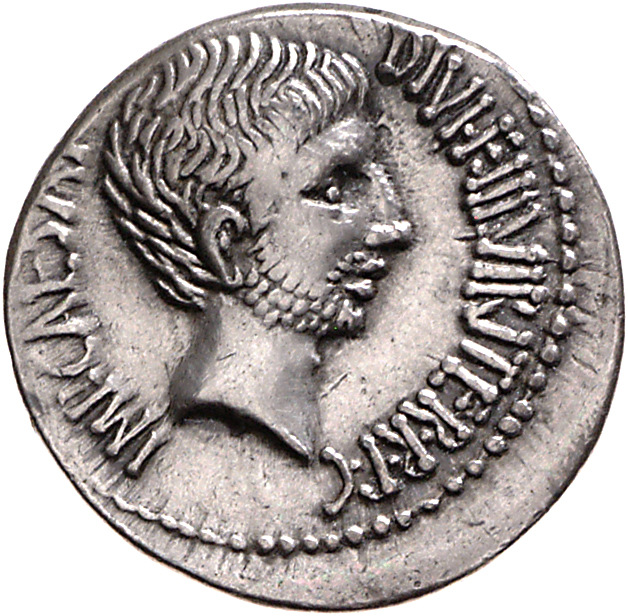
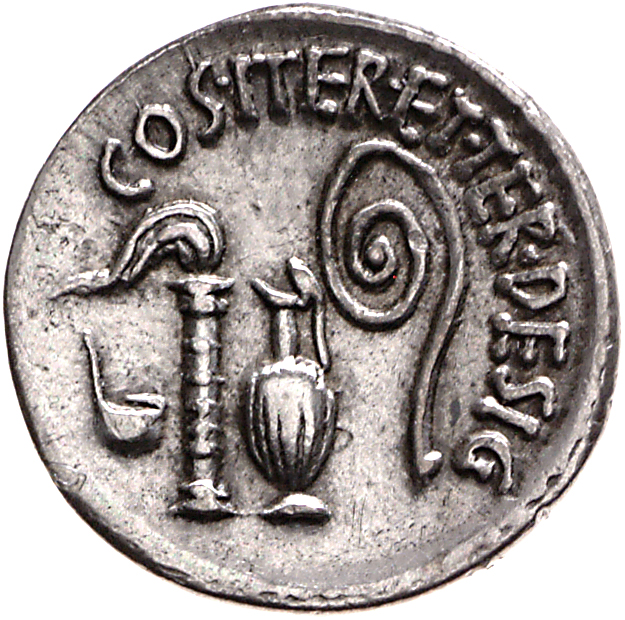
The brief overview of
coin portraits of both schemes shows clearly, that on the one
hand the characteristics are very generic and that on the other
hand the exactness of the execution by the die cutter varies
very much. The extreme youthfulness makes it impossible to
conclude that the Octavian portraits influenced that of Nikias.
The only parallel might be the beard sometimes attached to
Octavian’s image. But, on the other hand, an examination of the
bearded portraits of Octavian demonstrates that these show a
wide range of different beards with probably different meanings[71],
making it very difficult to find a reason why Nikias should have
copied this specific form of a beard.
It was already mentioned
that the underlying style of portraiture to which Nikias
referred was also used by some Romans. Among these, we easily
find one whose portraits show parallels to that of the Coan:
Mark Antony (figs. 11–13). Especially coins of 42 BC,
when his portraits still wore a mourning beard[72],
reveal astonishing parallels: the head has a similar general
structure; the hair consists of even locks which form clear
patterns across the forehead, the latter being divided by at
least one wrinkle; the brows contracted above the nose which is
quite big and slightly hooked; the use of mild verisms[73].
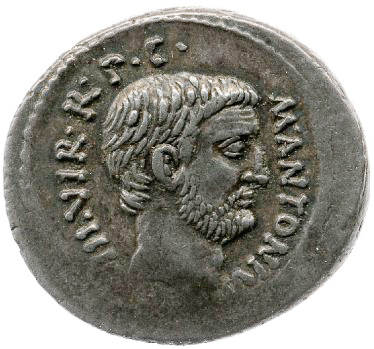
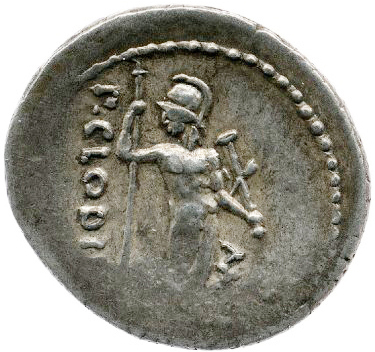
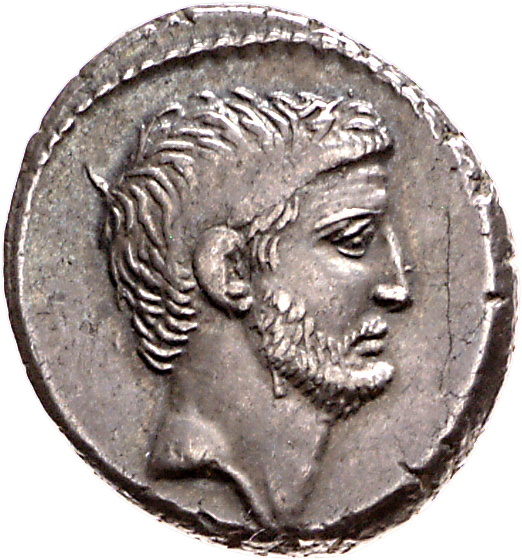
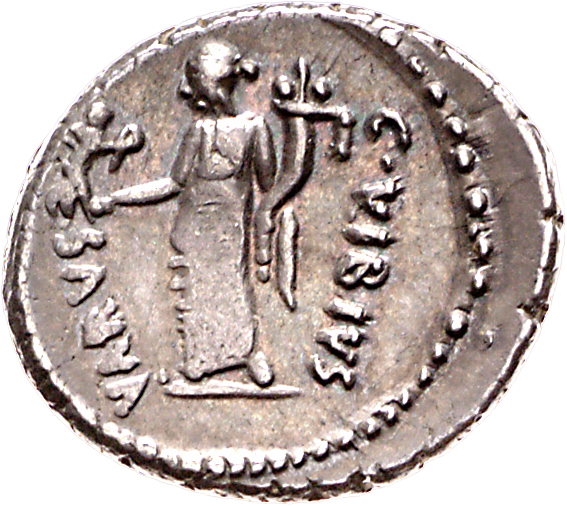
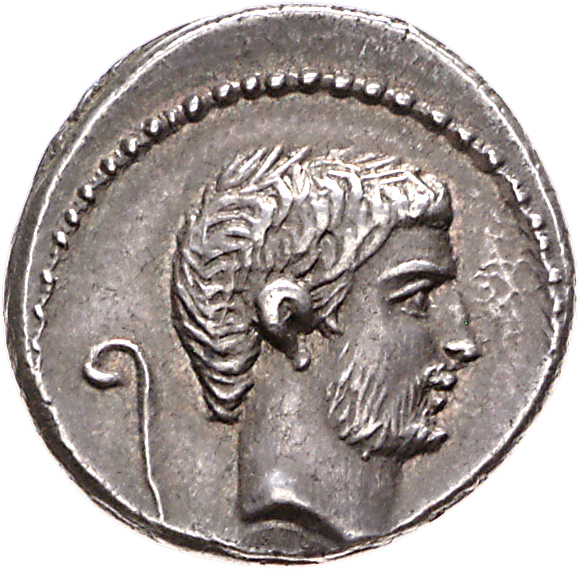
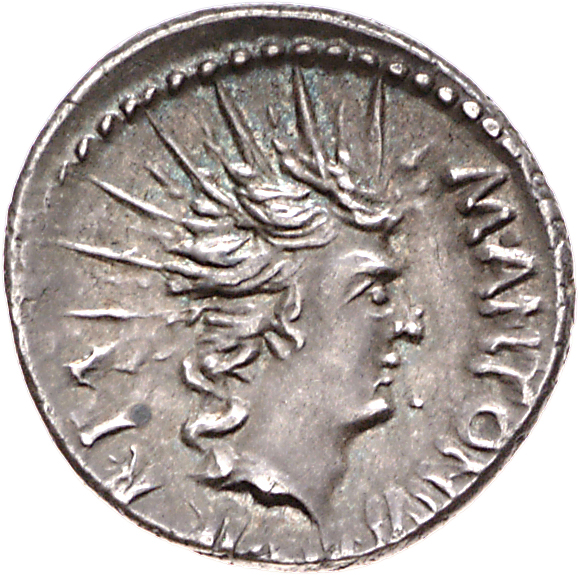
These similarities
clearly indicate, from my point of view, that the model
for Nikias’ portrait was that of Mark Antony. This makes Nikias
a forerunner of later client kings[74],
modelling their portraits according to that of Augustus[75].
Probably having come into his position only a short while before
having these coins minted, with at least Antony’s approval if
not his support, Nikias showed that he was a philoromaios and a philantonius with his
portrait. On the other hand, the traits of the portrait all
stemmed from a Greek tradition, fitting the likeness into the
line of Hellenistic royal portraiture.
III. Searching
for a sculptural portrait
Attempts to identify
a sculptural portrait of Nikias have been extremely scarce[76].
The marble bust of a boy with the inscription NIΚIΑΣ ΤΥΡΑNNΟΣ is
probably, should the inscription be ancient, a creation of later
times, when somebody wanted to recreate a representation of the
dead[77].
Dieter Salzmann has,
hesitantly[78],
drawn attention to the fact that there are similarities between
the discussed coin portrait and a marble one in the
Archaeological Museum of Rhodos[79]
(fig. 14). It is usually identified as Poseidonios which
cannot be true due to the fact that the person depicted is much
younger, has a distinctly different facial profile and lower
face and much more stylised eyes[80].
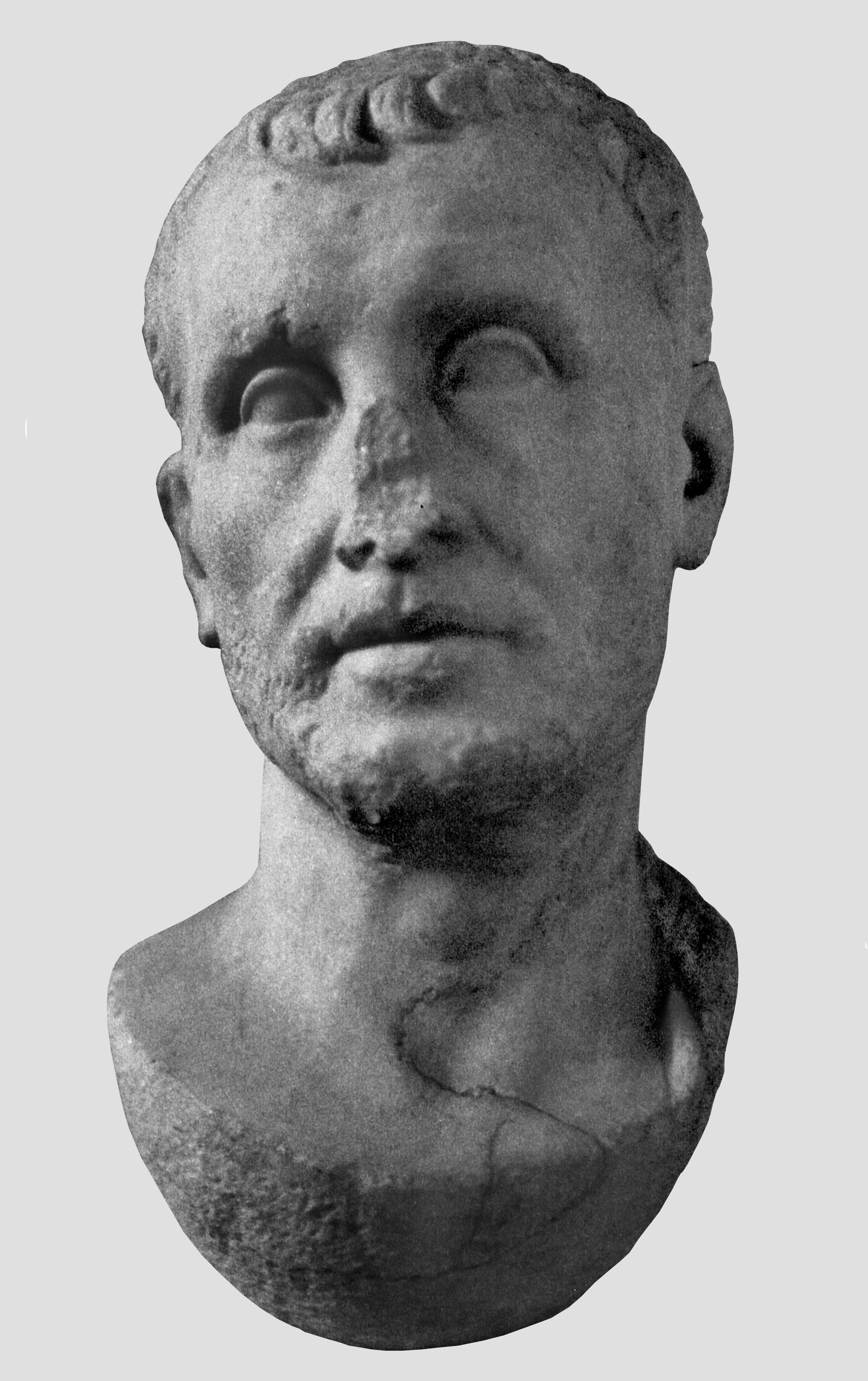
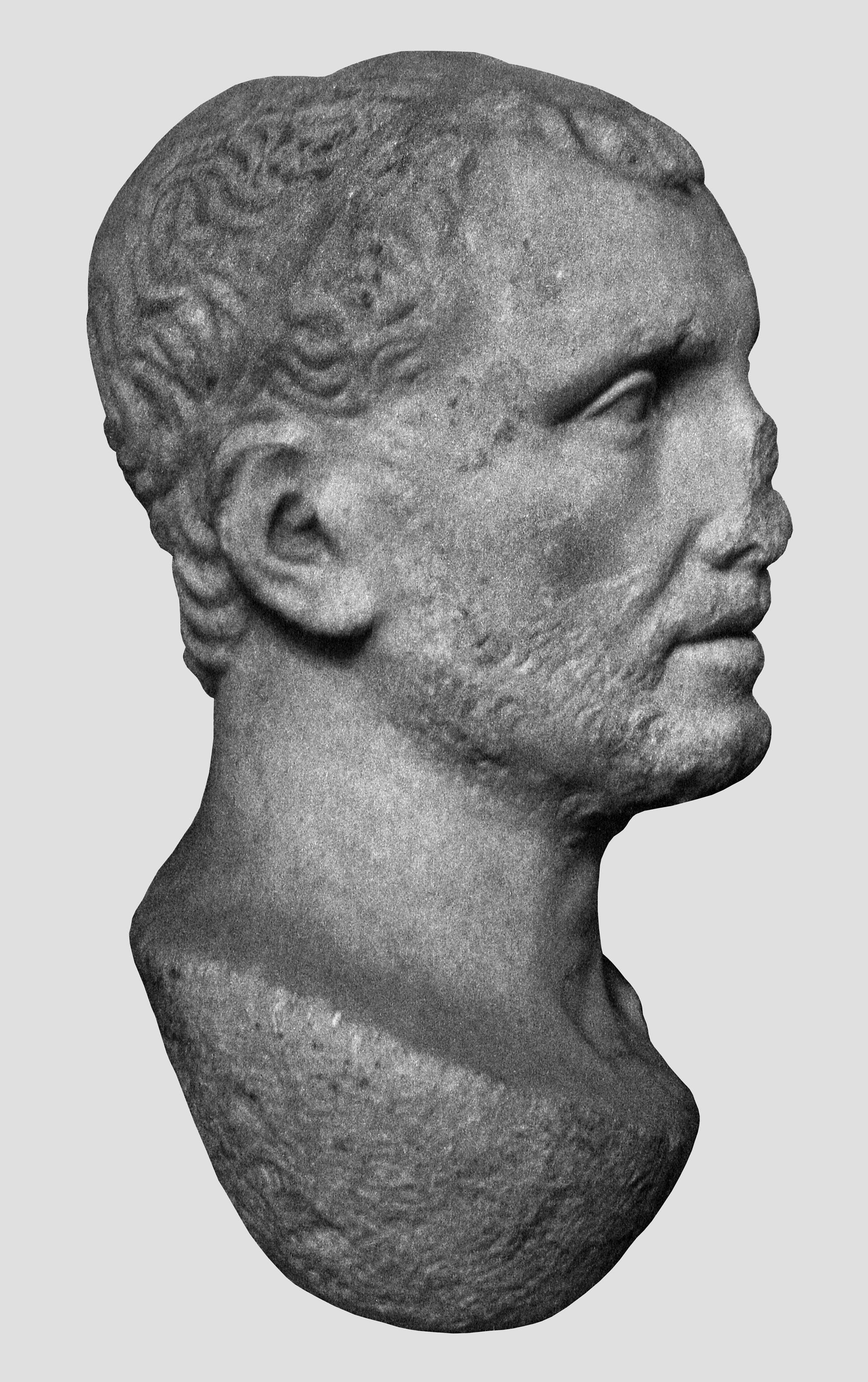
The portrait shows a
middle-aged man with markedly veristic features and wide open,
strongly stylized eyes. The receding forehead shows deep
wrinkles, the broken nose seems to have been hooked, that mouth
is girded with a deep cut. The hair is styled in small curls,
reaching down deeply in the middle of the forehead and receding
acute-angled towards the sides. The head shows traces of a band
probably added in metal.
In comparison with
Nikias’ portrait on the coins, the similarities one finds in the
lower section of the head (chin, mouth, nasolabial section,
cheek, nose) are soon weighed out by clear differences.
Especially three features prohibit an identification: the
profile line of the face is markedly different; the forehead of
the marble head is receding while that of the coin portrait is
steep; and the hairstyle shown on the coins lacks the
characteristically receding hairline of the marble portrait. The
Rhodian portrait can therefore not be identified as Nikias of
Cos, despite the fact that in these times one cannot yet expect
the accuracy of later portrait types[81].
IV. Concluding
remarks
Nikias of Cos is one
of the quickly rising and quickly falling illustrious characters
of the civil war Mediterranean between the mid-40s and 30 BC.
Obviously opportunistic, intelligent and eloquent, he managed to
get in touch with and become a close acquaintance of most of the
powerful Romans at that time. His cleverness not only allowed
him to manoeuvre his homeland through most of these difficult
times, he also built himself a nice position as a tyrant,
receiving high honours on Cos. The exact time at which this
happened is unclear. If we accept Antony’s coins of 42 BC as
direct models for Nikias’ portrait, we can assume that shortly
after this year, Nikias’ regime was established and his coinage
minted. How long it lasted is equally unsure, but around 31 or
30 BC it seems to have ended with Nikias’ death, burial and the
desecration of his tomb.
His portraits show
on the one hand his close connection with Antony while marking
him on the other as a Hellenistic ruler. The headdress, a wreath
with a tainia, probably connects him with the cult of the main
god of the island, Asklepios, figuring on the reverse of the
coins, and marks him as victorious. The coin series, as we see,
embodies the complete political programme of a small tyrant
between Hellenistic kingdoms, Rome and his homeland, trying to
find his place in the dangerous times of the civil war which was
sweeping over the whole Mediterranean world.
*
Again, a variety of colleagues and
friends have helped me during the work on this paper.
For discussions, literature, and a variety of hints I
thank Sebastian Whybrew, Tobias Esch, Simone Killen,
Vassiliki Stefanaki, Despoina Nikas, Frank Daubner,
Dieter Salzmann and Andrew Burnett. Of course, all
remaining mistakes are mine.
[1]
Literature on Nikias is not abundant. The most complete
account of his career is still Herzog 1922, 190–216.
Research has since then not produced significant new
results concerning the reconstruction of his life and
career, which clearly reflects the lack of extent
sources; compare Syme 1961, 25–28; Bowersock 1965, 45
f.; Sherwin-White 1978, 141–145; Buraselis 2000, 30–65
(criticism of his analysis of Nikias’ coinage below). D.
Salzmann has, in his unpublished Habilitationsschrift,
dealt with Nikias’ coinage and portrait; Salzmann 1986,
184–187 (corpus of coins). 239–243 (analysis). A
detailed study of his coinage (including a die study)
has recently been published by V. Stefanaki; Stefanaki
2012, 126–130. 281–283 series XIX emission 51. I am
grateful to her for sending me a scan from
that publication.
[2]
Herzog 1922.
[3]
Herzog 1922, 191. Nikias’ youth and his
family remain unknown. In a later anecdote it is
mentioned that an ewe belonging to Nikippos (= Nikias)
once gave birth to a lion, thereby predicting him future
kingship while he was still an ordinary person; Ael.
Poik. 1,29: λέγουσι Κώων παῖδες ἐν Κῷ τεκεῖν ἔν τινι
ποίμνῃ Νικίου τοῦ τυράννου οἶν: τεκεῖν δὲ οὐκ ἄρνα ἀλλὰ
λέοντα. καὶ οὖν καὶ τὸ σημεῖον τοῦτο τῷ Νικίᾳ τὴν
τυραννίδα τὴν μέλλουσαν αὐτῷ μαντεύσασθαι ἰδιώτῃ ἔτι
ὄντι. Deducing from the episode that he was a shepherd
guarding other people’s animals and not owning any
cattle is not probable; contra Buraselis 2000, 38 f.
Certainly his family must have been at least of some
standing and income as their son could become a
philologist; cf. Sherwin-White 1978, 142.
[4] Suet.
gramm. 14: Curtius Nicias haesit Cn. Pompeio et
C. Memmio; sed cum codicillos Memmi ad Pompei
uxorem de stupro pertulisset, proditus ab ea,
Pompeium offendit, domoque ei interdictum est;
»Curtius Nicias was an adherent of Gnaeus Pompeius and
Gaius Memmius; but having brought a
note from Memmius to Pompey’s wife with an infamous
proposal, he was betrayed by her, lost favour with
Pompey, and was forbidden his house« (translation: J. C.
Rolfe, Loeb Classical Library, Suetonius II, 1914). That
he left Rome with Memmius is suggested by Herzog 1922,
194 since for some years our sources do not mention him.
[5]
Herzog 1922, 191.
[6]
Contra Herzog 1922, 194.
[7] Cic.
ad Att. 7,3,10. Whether he was an old acquaintance of
Cicero and Atticus, as Herzog 1922, 195 suggests, cannot
be deduced from the letter.
[8] For
the identification of this Nikias see Herzog 1922, 196
n. 1. He also must have closer contact to Brutus, as can
be restored from Cic. ad Att. 13,9; Herzog 1922, 203.
[9] Cic.
ad fam. 9,10. Compare Suet. gramm. 14.
[10] Cic.
ad Att. 12,26,2.
[11] Cic.
ad Att. 12,51,1. 53.
[12] Cic.
ad Att. 13,1,3.
[13] Cic.
ad Att. 13,52,2.
[14] Cic.
ad Att. 14,9,3; 15,20,1.
[15] The
material for the Geographica seems to have been
collected mainly between the years 20 and 7 BC. The
formulation must not mean that Nikias was a tyrant in
that time (which is unlikely considering his coinage).
Strabo was in Rome from 44 BC onwards and was presumably
well informed about the political events during the
civil war, especially those concerning Greece; Lasserre
1979.
[16]
Strab. 14,2,19.
[17]
Herzog 1922, 206–208.
[18] App.
civ. 4,66–70.
[19] As
had been the case in Xanthos, according to Brutus. Text
and translation of the letters have been compiled in
English by Jones 1994 (the letter to Rhodes ibid. p. 224
f.), who also convincingly argues for the letters to be
authentic. As to this question, I share the view brought
forward by Bengtson 1970, 37 f., Jones 1994 and others
that the letters themselves are indeed genuine, though
the answers are probably not.
[20] For
example, App. Civ. 4,71; Cass. Dio 47,33. Several coins
refer to the event with their images or details of
imagery. They have been discussed in detail by Hollstein
1994, 122–126. See also Woytek 2003, 505–528; Biedermann
2018.
[21]
Jones 1994, 226 n. 26.
[22]
Herzog 1922, 211 f.
[23] Cf.
the inscriptions on bases of statuettes offered to the
θοὶς πατρᾡοις for Nikias’ well-being: Paton – Higgs
1891, nos. 76–80; IG XII, 4, 2, 682. 683. 685–690. 692.
695. 697–704. 706–711. For the phenomenon of dignitaries
dominating politics in Hellenistic cities with (for some
time at least) the consent of their fellow citizens,
which lead to exclusivity in politics and the tendency
to a dynastic trend in civic offices see Scholz 2008;
Daubner 2021 (with examples from Kalindoia).
[24] For
similar practices in Hellenistic kingdoms see Kyrieleis
1975, 137. 145; Dahmen 2001, 10 f. with examples. For
the difficulty in specifying these ›private‹ contexts of
small-scale sculpture see the summarizing remarks in
Schreiber 2016, 127–129. There is, however, no evidence
for the assumption that Nikias demanded or installed a
cult; contra Taeger 1957, 356 f.
[25]
For this distinction
see Pfeiffer 2008, 31–33. For dedications of statuettes
and statues of the dedicators see Himmelmann 2001. The
phenomenon of dedicating a statue of one god to another
discussed by Chaniotis 2003a, 431–433 with further
literature; Chaniotis 2003b, 11 f. with some examples
from Roman imperial cult. Grammar of dedications and its
change: Veyne 1962; Ma 2007; Kajava 2011, 562 f. with
further literature.
[26]
Herzog 1922, 208–212. Compare the honours for Theophanes
and Potamon at Mytilene: Pawlak 2020; Salzmann 1985
(concerning the portrait of Theophanes); Taeger 1957,
369 f.
[27]
Strab. 14,2,19.
[28]
Contra Herzog 1922, 208.
[29] Cf.
Boethos of Tarsos (Strab. 14,5,14); Straton of Amisos
(Strab. 12,3,14). For all these measures and further
examples see (especially for the instalment of new
client kings) see Raillard 1894; Buchheim 1960, 11–28;
Magie 1950, 427–436.
[30]
Cass. Dio 51,8,3.
[31] The
text of the statute is damaged and incomplete. At some
point the name of the triumvir was erased and the stele
smashed to pieces. M. Crawford rightly points out that
the latter must not necessarily have happened in
antiquity; the completest publication of the inscription
Crawford 1996, 497–506; see also Buraselis 2000, 25–30.
[32]
Krinagoras of Mytilene, AP IX.81:
Μὴ εἴπης
θάνατον βιότου ὅρον· εἰσὶ χαμοῦσιν
ὡς ζωοῖς ἀρχαὶ
συμφορέων ἕτεραι.
Ἄθρει Νικίεω
Κῴου μόρον· ἤδη ἕκειτο
εἰν Ἀίδη,
νεκρὸς δ’ ἦλθεν ὑπ’ ἠέλιον·
ἀστοὶ γὰρ
τύμβοιο μετοχλίσσαντες ὀχῆας
εἴρυσαν ἐς
ποινὰς τλήμονα δισθανέα.
»Tell me not that death is
the end of life. The dead, like the living, have their
own causes of suffering. Look at the fate of Nicias of
Cos. He had gone to rest in Hades, and now his dead body
has come again into the light of day. For his
fellow-citizens, forcing the bolts of his tomb, dragged
out the poor hard-dying wretch to punishment«.
Translation W. R. Paton, The Greek Anthology III, Loeb
Classical Library (New York 1915) p. 43.
The date of
the epigram has to remain unsure; Geffcken 1922, 1861.
[33] SEG
8.13. For the provenance of the inscription see Harper
et al. 2020.
[34] Cos
was fined by Octavian for taking the side of Antony;
Herzog 1922, 215 with sources.
[35] RPC
I, nos.
2724.
2725.
2726.
2728.
2729.
2730.
2731;
Stefanaki 2012, 126–130. 281–283. The following
magistrates are attested: ΧΑΡΜΥΛΟΣ, ΠΟΛΥΧΑΡΗΣ,
ΟΛΥΜΠΙΧΟΣ, ΚΑΛΛΙΠΠΙΔΗΣ, ΕΥΚΑΡΠΟΣ, ΕΥΚΑΡΠΟΣ, ΔΙΟΦΑΝΤΟΣ
and ΑΝΤΙΟΧΟΣ.
[36]
Herzog 1922, 208; Syme 1961, 27 n. 68; Sherwin-White
1978, 144; Stefanaki 2012, 126.
[37]
Habicht 2000, 322–326. The study of the coinage between
the fourth and second century BC by H. Ingvaldsen
reached a similar conclusion; Ingvaldsen 2002, 187–206.
[38]
Stefanaki 2012, 126.
[39]
Stefanaki 2012, 129. For the phenomenon in general
compare Kroll 1997.
[40]
Stefanaki 2012, 127–130. For the ›fleet coinage‹ see v.
Bahrfeldt 1905; Buttrey 1953; Amandry 1986; Amandry
1987a; Amandry 1987b; Martini 1988; Amandry 1990; RPC I,
p. 284 f. nos.
1453–1461.
1462–1470.
4088–4093;
Kroll 1997, 124. 128 f.; Fischer 1999, 191–211; Amandry
2008; Amandry – Barrandon 2008, 230–232.
[41] The
only surviving examples of his portraiture, since the
small bust (»bustino«) of a child with the inscription
NIΚIΑΣ ΤΥΡΑNNΟΣ has to be considered depicting somebody
else and the inscription incised at a later point;
original publication Jacopitch 1928, 95 fig. 77. The
bust was in the ›Castello dei Cavalieri‹ of Cos and was
recorded during a restoration campaign 1915–1916, during
which a catalogue of over 1300 marble artefacts was
collected. The pieces came from a variety of findspots
and collections more or less all over the island of Cos;
Jacopitch 1928, 92. Buraselis 2000, 41 n. 61 states he
was not able to trace the piece. It has to be considered
lost.
[42] Dies
are indicated according to Stefanaki’s system; Stefanaki
2012, 281–283. Some of the coins collected by her have
continued their journey through private collections and
auction houses: Stefanaki 2012, no. 2184α = Bertolami
Fine Arts, ACR Auctions, Auction 4 (05.12.2011) no. 7;
Stefanaki 2012, no. 2231 = CNG, Electronic Auction 145
(09.08.2006) no. 95 = CNG, Electronic Auction 490
(21.04.2021) no. 23; Stefanaki 2012, no. 2198 = Fritz
Rudolf Künker GmbH & Co. KG, Auktion 333 (16.03.2020)
no. 318; Stefanaki 2012, no. 2224 = Gemini LLC, Auction
10 (13.01.2013) no. 118; Stefanaki 2012, no. 2205 =
Stacks, Bowers and Ponterio, January 2017 NYINC Auction
(12.01.2017) no. 2057 (in her list The New York Sale 11
[11.01.2006] no. 202 is missing for this coin).
[43] BMC
Caria, 213 no. 196–200; Sherwin-White 1978, 142.
[44]
Stefanaki 2012, 126. 281.
[46]
Buraselis 2000, 31–33. He clearly has in mind the
so-called Heroenbinde, which should have a different
form; Martin 2012.
[47] RPC
I, p. 452; Buraselis 2000, 31.
[48]
Salzmann 2012.
[49]
Buraselis 2000, 32.
[50]
Compare Salzmann 2012, 358 n. 83; Martin 2012, 270 with
some examples.
[51] For
the combination of tainia and laurel wreath, focussing
on Roman iconography, see Biedermann 2020.
[52]
Ps.-Hippokr. Ep. 11 (Smith 1990, 58–61); Sherwin-White
1978, 339. Unfortunately, cypress is nowhere attested to
have played a role in the cult of the healing god. Olck
1901, 1915–1938 for the cypress in cult, esp. 1923–1932;
cypress in medicine 1913–1915. Attested as plants for
wreaths in connection with the cult of Asklepios are
olive, laurel and oleander; Nilsson 1906, 410; Blech
1982, 312.
[53]
Ps.-Hippokr. Ep. 11; Thraemer 1886, 628.
[54] I
thank Cathy Lorber for doubting my earlier
identification and Thibaud Messerschmid as well as Simon
Pfanzelt (both Botanischer Garten München-Nymphenburg)
for their botanical expertise.
[55] See
for example Lehmann 2012; Biedermann 2020, esp. 34–41.
[56]
Biedermann 2020, 25 f. 40 f.
[57] We
do not know what the insignia of the priests and other
cult personal looked like; Ps.-Hippokr. 11.
[58] RPC
I, p. 452.
[59]
Buraselis 2000, 31–35.
[60]
Stefanaki 2012, pl. 493–499. 514.
[61]
Salzmann 2012, 362–379 for a quick overview of
numismatic sources. A sculpture with a bearded portrait
interpreted frequently as a Greek, the so-called
Thermenherrscher, has convincingly been identified as Q.
Caec. Metellus Macedonicus by Stephan Lehmann; Lehmann
1997.
[62]
Among the Roman portraits those of Marcus Antonius
(Biedermann 2018, 18–43), Gnaeus Pompeius Magnus (Trunk
2008), Sextus Pompeius (Biedermann 2018, 697–703),
Lucius (?) Ahenobarbus (Lahusen 1989, 28 f.) or, as a
late example, that of Agrippa (Fittschen et al.
2010, 29–33 no. 16, esp. p. 30) can be
named. For the conventions behind this style of
portraiture Zanker 1976; Zanker 1978, 34–39; Balty 1982;
Lahusen 1989, 75–81; Fittschen 1991a (opposing Giuliani
1986). Bearded Greek and Roman private portraits with
veristic traits along these lines are known en masse
from intaglios and cameos from the second and first
centuries BC; compare Vollenweider 1974, 25, 1–7; 44, 1;
45, 1; 129, 1–12 (interpreted as Greeks) and Biedermann
2013 with Roman examples. Bearded and veristic royal
portraiture collected by Iossif – Lorber 2009, focussing
on Seleucid examples, but including others too.
[63] RPC
I, p. 452. Buraselis 2000, 31.
[64] See
above and Herzog 1922, 212 f.; Sherwin-White 1978, 145;
Crawford 1996, 497–506 (text and commentary of the
lex fonteia); Buraselis 2000, 25–30.
[65] For
the portrait type in general see Brendel 1931, 40–54;
Curtius 1940, 47–53; Zanker 1978; Hausmann 1981,
535–550; Massner 1982, 32–36; Boschung 1993, 11–22. 61
f.; Fittschen – Zanker 1994, 1 f. no. 1; Fittschen 1991,
161–163
[66] For
the following division into schemes and the coin types
showing these portraits Biedermann 2018, 260–310 esp.
295–301. For the term ›portrait scheme‹ in contrast to
›portrait type‹ Biedermann 2018, 15–17.
[67] For
the complete account of types cf. Biedermann 2018, Oct.
M 1–16. 32. 33 (figs. 550–621. 742–764).
[68] The
series is, as far as I see, the first example in which
the three-dimensional prototype was depicted from both
sides.
[69]
Biedermann 2018, 15–17. 260–310 esp. 295–301.
[70] For
the complete account of types see Biedermann 2018, Oct.
M 18. 20–22. 38. 40. 41; figs. 628–644. 648–685.
808–829. 831–853.
[71]
Biedermann 2013, 35–38; cf. Hertel 2021 now with partly
differing results.
[72]
Biedermann 2013, 38–44; Biedermann – Haymann 2015, 301
f.
[73] For
the types cited here Biedermann 2018, Ant. M 15. 16. 18.
For Antony’s portrait and the schemes in general compare
Biedermann 2018, 18–43.
[74]
Another early example is Tarcondimotus I of Cilicia,
whose portrait is clearly influenced by that of Caesar
(the huge amount of wrinkles, crow’s feet, leather-like
skin and bony substructure of the face) while at the
same time picking up what seem to be elements of the
›antonian‹ style of portraiture, namely in the even,
curly, short hair and the muscular, thick neck. He seems
to have been born around 100 BC, having thus reached an
age of probably between 50 and 70 years before he was
installed as a client king by Antony; Wright 2009, 74.
For Tarcondimotus I and his coinage see RPC I, no.
3871;
Sayar 2001, 373–375; Tobin 2001 (focus on the dynasty);
Wright 2008, esp. 115–118; Wright 2009 and Wright 2012
(with focus on the contacts of his dynasty with the
Romans).
[75] The
most prominent example being Juba II; cf. Salzmann 1974;
Fittschen 1974. Dahmen 2010 gives a great general
overview if the phenomenon.
[76] That
there must have been portrait statues is proven by a
base found on Cos which according to its measurements
once carried a statue; Herzog 1899, 67. 128 Nr. 192.
[77] For
the bust and the identification see Jakopitch 1928, 96;
Sherwin-White 1978, 142 n. 323. Discussion and
falsification Salzmann 1986, 243.
[78] I
thank Dieter Salzmann for drawing my attention to the
head and discussing it with me.
[79]
Salzmann 1986, 242 f. Archaeological Museum of Rhodos,
inv. E48. For a discussion of the head and a
bibliography see Bairami 2017, Kat. 068.
[80]
Salzmann had already recognized that the head follows
(as do the coin portraits discussed here) the same style
of portraiture as that of Poseidonios; Salzmann 1986,
242.
[81] See
above, note 69.